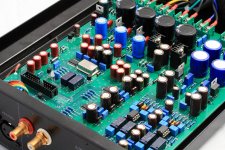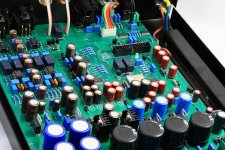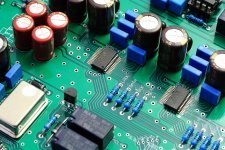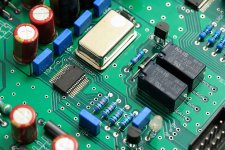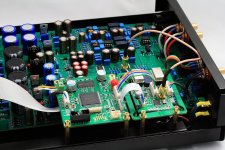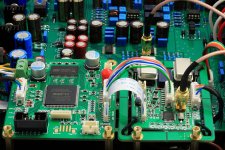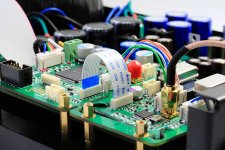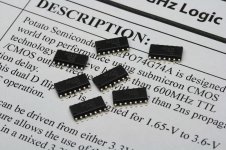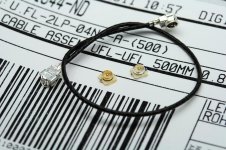Delta Sigma DAC's are supposed to be less sensitive to jitter
There is proportional between jitter, frequency and slope of a signal (step size, step density).
Yes, jitter modulating HF quantization noise folding it down to baseband.Do the modulations on the clock fold over from the actual clock or the sample rate?
the same, phase modulation of input signalI'm not clear what the effect of jitter on the clock system will be
yes, but measurement methods are not the same -> numbers are not the samePhase jitter, time domain jitter, phase noise, residual FM are all different descriptions of the same phenomena
For Nyquist dacs and 2562\8741 only 10Hz-10kHz is importantInteresting, the HF component may be less important
differs absolutely, for DS depending on order of modulator, levels of the DAC, filtering in digatal domain and at discrete-to-continuous time interface.Perhaps not, but how would they differ?
no, translate, but less then a simple CMOS PWM outputThe original breed of DS DACs (Bitstream from Philips - example TDA1547) had switched-capacitor (SC) architecture. This means the clock can jitter but that doesn't translate into an amplitude variation at the DAC's output.
no, digital filtering is digital filtering, not the filtering at discrete-to-continuous time interfaceI wonder if that's what Nazar was referring to in mentioning 'digital filter'
CS, AK, WM, and PCM4104 all has DCT (Direct charge transfer) DACs, but differentthe Cirrus DACs I think have SC filtering after the DAC itself
AD and TI dont use DCT dacs because DCT dacs are very power consuming and complicateda paper by Bob Adams (ADI) seemed to suggest that AD parts don't, but don't quote me on that
First mission: Modding the WM8741 DAC
I have a WM8741 DAC. It has two WM8741 working in differential mono mode and a WM8805 DIR. I was full with expecting but got a bit disappointment on the clarity I don’t know why. I suspect it was the LPF design problem but I didn’t confirm. I am gonna mod it by my I2S FIFO now.
On board, there are two relays switching between internal and external I2S sources. Just disassemble them by a SMT soldering station and bridge the I2S signals by input and output cables linked to the FIFO. The MCLK goes separately by a 50 ohm coaxial cable. I make use of an on board 5V LDO power the FIFO. The FIFO board together with the frame of the clock board was fixed to the base by 4 screw standoffs. I attached the pictures. Things look pretty easy.
I ran it by a $3 oscillator just to confirm everything is OK. It sounds almost the same quality level as the WM8805 did. Not like my AD1955 DAC which sounds quite different with and without the FIFO. I think there might be two reasons: 1, the WM8805 has better jitter performance than DIR9001 and need the FIFO equipped with a bit better secondary clock to get improvement; 2, the WM8741 is not as sensitive as AD1955 to the MCLK jitter. However the clarity problem is still there, I believe it was analog problem and has nothing to do with the digital audio signals.
Anyway, I’ve already started collecting the oscillators other than $3 ones for the later on testing and evaluation. I’m gonna try different clocks the next steps.
for the later on testing and evaluation. I’m gonna try different clocks the next steps.
I have a WM8741 DAC. It has two WM8741 working in differential mono mode and a WM8805 DIR. I was full with expecting but got a bit disappointment on the clarity I don’t know why. I suspect it was the LPF design problem but I didn’t confirm. I am gonna mod it by my I2S FIFO now.
On board, there are two relays switching between internal and external I2S sources. Just disassemble them by a SMT soldering station and bridge the I2S signals by input and output cables linked to the FIFO. The MCLK goes separately by a 50 ohm coaxial cable. I make use of an on board 5V LDO power the FIFO. The FIFO board together with the frame of the clock board was fixed to the base by 4 screw standoffs. I attached the pictures. Things look pretty easy.
I ran it by a $3 oscillator just to confirm everything is OK. It sounds almost the same quality level as the WM8805 did. Not like my AD1955 DAC which sounds quite different with and without the FIFO. I think there might be two reasons: 1, the WM8805 has better jitter performance than DIR9001 and need the FIFO equipped with a bit better secondary clock to get improvement; 2, the WM8741 is not as sensitive as AD1955 to the MCLK jitter. However the clarity problem is still there, I believe it was analog problem and has nothing to do with the digital audio signals.
Anyway, I’ve already started collecting the oscillators other than $3 ones
Attachments
Last edited:
Hi Ian, I look at you pictures, DAC is very poorly designed (maybe by audiophiles )
)
what type?I ran it by a $3 oscillator
nothing surpriselyNot like my AD1955 DAC which sounds quite different with and without the FIFO
8804 has 100Hz LPF corner frequency, 9001 - 10kHz (absolutely dont reject necessary input jitter), 8804 with external good generator has jitter <50ps RMS (find the time I measure exactly), 9001 - 50...60ps RMS. 9001 very poorly designed, very sensitivity to "glitches", dont work stable.the WM8805 has better jitter performance than DIR9001 and need the FIFO equipped with a bit better secondary clock to get improvement
Approximately 50 times lowerthe WM8741 is not as sensitive as AD1955 to the MCLK jitter
this DAC is all complete problem)I believe it was analog problem and has nothing to do with the digital audio signals
must be "from 2 (PWM, PDM) to 64"from 2 (PWM, PDM) to 78
Nazar:
How are you measuring jitter? Method, hardware and type will help in making meaningful comparisons.
I have not been impressed with the sonics from Wolfson (not sure why) and have heard other reports to the same effect. I have also heard from very skilled designers that the Wolfson spdif receiver is a nightmare to get working and the net results from the really easy to use AKM were better.
How are you measuring jitter? Method, hardware and type will help in making meaningful comparisons.
I have not been impressed with the sonics from Wolfson (not sure why) and have heard other reports to the same effect. I have also heard from very skilled designers that the Wolfson spdif receiver is a nightmare to get working and the net results from the really easy to use AKM were better.
I need to go office one company who produce generators. Methods all standard, high speed DSO & Spectrum analizer. (Agilent, Rhode&schwarz)How are you measuring jitter? Method, hardware and type will help in making meaningful comparisons.
I use 8804 since he was produced, very good reciever with no problem at all, all others receivers (dir,cs,ak,ym,phil) has almost NO rejection of jitter in right range (LPF corner freq. >10kHz), needs second PLLI have also heard from very skilled designers that the Wolfson spdif receiver is a nightmare to get working and the net results from the really easy to use AKM were better.
8804 has 100Hz LPF corner frequency, 9001 - 10kHz (absolutely dont reject necessary input jitter), 8804 with external good generator has jitter <50ps RMS (find the time I measure exactly), 9001 - 50...60ps RMS. 9001 very poorly designed, very sensitivity to "glitches", dont work stable.
Approximately 50 times lower"
Hi Nazar, Thank you so much for confirming what I suspected.
this DAC is all complete problem)
must be "from 2 (PWM, PDM) to 64"
I wanted to try WM8741 and WM8805, that was only reason I bought this DAC. But the clarity problem make me having some negative feeling on them. You said the DAC was all complete problem, do you have any idea to improve the clarity of WM8741?
What you mean 'must be "from 2 (PWM, PDM) to 64"'? Thanks. Ian
Last edited:
I need to go office one company who produce generators. Methods all standard, high speed DSO & Spectrum analizer. (Agilent, Rhode&schwarz)
I use 8804 since he was produced, very good reciever with no problem at all, all others receivers (dir,cs,ak,ym,phil) has almost NO rejection of jitter in right range (LPF corner freq. >10kHz), needs second PLL
And following from your earlier comment thgose each measure in different ways, depending on how they measure. The phase noise analyzer measures the obvious way, the scope several possible ways. I just ran across this really good background on the subject (which will save a lot of difficult explanations for others who happen on this):http://www.designcon.com/newsletter/white_paper_april.pdf
I can measure directly to 30 pS RMS but that doesn't seem to be enough and its only cycle to cycle measurement. Any info you can provide from your experience will help in determining my next steps.
I understand that you have had success with the Wolfson receiver. I have read their white paper on the different cutoff on the PLL. Its interesting but the programming looked to be a major issue. Is there anything special you did?
http://www.sitime.com/support2/documents/AN10007-Jitter-and-measurement.pdfAny info you can provide from your experience will help in determining my next steps.
no, only correct PCB layout, and i use hardware mode because i dont need some special functions in software mode.Is there anything special you did?
of course, i work now with this dac, but its not a diy project.do you have any idea to improve the clarity of WM8741?
corrections to my post 81What you mean 'must be "from 2 (PWM, PDM) to 64"'? Thanks. Ian
Quote:
I ran it by a $3 oscillator
what type?
Regards,
Nazar
I have a WM8741 DAC. It has two WM8741 working in differential mono mode and a WM8805 DIR. I was full with expecting but got a bit disappointment on the clarity I don’t know why. I suspect it was the LPF design problem but I didn’t confirm. I am gonna mod it by my I2S FIFO now.
On board, there are two relays switching between internal and external I2S sources. Just disassemble them by a SMT soldering station and bridge the I2S signals by input and output cables linked to the FIFO. The MCLK goes separately by a 50 ohm coaxial cable. I make use of an on board 5V LDO power the FIFO. The FIFO board together with the frame of the clock board was fixed to the base by 4 screw standoffs. I attached the pictures. Things look pretty easy.
I ran it by a $3 oscillator just to confirm everything is OK. It sounds almost the same quality level as the WM8805 did. Not like my AD1955 DAC which sounds quite different with and without the FIFO. I think there might be two reasons: 1, the WM8805 has better jitter performance than DIR9001 and need the FIFO equipped with a bit better secondary clock to get improvement; 2, the WM8741 is not as sensitive as AD1955 to the MCLK jitter. However the clarity problem is still there, I believe it was analog problem and has nothing to do with the digital audio signals.
Anyway, I’ve already started collecting the oscillators other than $3 onesfor the later on testing and evaluation. I’m gonna try different clocks the next steps.
I also have this WM8741 DUAL DAC, too
I think there're some problem on LPF, If you see input point before Opamp you can jump these signal to external voltage gain and use them.
Too many different sound and more liquid if you use only 16BIT function. After I used >176.4KHz there'remany noise and error signal I don't knor why ?
Lyricxx Audxx ?
Thanks
Anadigit
I also have this WM8741 DUAL DAC, too
Thanks Anadigit, Yes we got the same toy. It seems the designer made a lot of effort, but he didn't get the right answer, as well as went through very careful test.
Thank you so much for those suggestions, I'll go through the LPF and the whole analog section this weekend to see if I could make it better.
Ian
First of all, this DAC is base on a DIY project but just assembled with a chassis, which was same as something prototype only, the marketing of the factory is very smart, they sell prototype to DIYer for compensate the R&D cost, but if you know the local price, you will forgive and willing to pay a trial, since it is just in US dollar around $200 for a built one.
The complete design which no more kit and marketing as a factory made is this one:
5i-10 ?WM8741 ?????-HIFI??
Other then new layout, circuit improvements, new calculation and some new tricks, overall the new version sound smoother and more details then the KIT version.
However, I don't understand the terms of "clarity" Ian you refer to, is simply the sound, an audition feelings or something base on a technical terms? Since if you compare WM8741 to AD1955 or else, you will never get a "clarity" sound, because WM8741 is the most "analog sound" DAC chip in the market right now.
The complete design which no more kit and marketing as a factory made is this one:
5i-10 ?WM8741 ?????-HIFI??
Other then new layout, circuit improvements, new calculation and some new tricks, overall the new version sound smoother and more details then the KIT version.
However, I don't understand the terms of "clarity" Ian you refer to, is simply the sound, an audition feelings or something base on a technical terms? Since if you compare WM8741 to AD1955 or else, you will never get a "clarity" sound, because WM8741 is the most "analog sound" DAC chip in the market right now.
I also have this WM8741 DUAL DAC, too
I think there're some problem on LPF, If you see input point before Opamp you can jump these signal to external voltage gain and use them.
Too many different sound and more liquid if you use only 16BIT function. After I used >176.4KHz there'remany noise and error signal I don't knor why ?
Lyricxx Audxx ?
Thanks
Anadigit
This DIY version the WM8805 is only working at hardware mode, which only support 24/48, to support over 48 the WM8805 should work at software mode, however, even software mode, the WM8805 still have problem with 176.4, because WM8805 suppose only recognise 44.1, 48, 96 and 192 only.
Now the new version other then working at software mode, they also pump the MCLK from recommanded 12MHz to 24Mhz, this made the WM8805 also recognise 88.1 and 176.4.
in HM 8804\8805 support 32,44.1,48,88.2,96 and 192WM8805 is only working at hardware mode, which only support 24/48
Other then new layout, circuit improvements, new calculation and some new tricks, overall the new version sound smoother and more details then the KIT version.
However, I don't understand the terms of "clarity" Ian you refer to, is simply the sound, an audition feelings or something base on a technical terms? Since if you compare WM8741 to AD1955 or else, you will never get a "clarity" sound, because WM8741 is the most "analog sound" DAC chip in the market right now.
Hi Goldkenn,
Thanks for those informations. Do you have any idea on how to improve this WM8741 DAC? I bought it almost a year ago, I suspect it was their first edition. Still some problems other then the one I mentioned, things like when you go the 96KHz directly, it will generate very big noise on the speakers if you didn't swithch the button to the high Fs mode, and this will be happend again and agian each time when you power up it because it didn't save the last setting. and....it's not very stable at 192Khz...
Talking about clarity, trust me Goldkenn, it's very immportant for a DAC. If you have a FIFO together with a really nice low phase noise clock, you will find out how much details we didn't hear before. The only significant thing I'm asking for a DAC is originally music playing back, as pure as possible. If I ask for some 'tasty' likes 'analog sound', I would try tube stage, preamp or even different cables. But any way, that's only my personal point of view
Last edited:
in HM 8804\8805 support 32,44.1,48,88.2,96 and 192
But refer to this DAC manufacturer, HM of WM8805 only "suppose" to support over 48K, over 48K very depend on the stability and quality of the source signal, they do shown they can go through up to 192K in lab, but non of the commercial player in market could do, in terms of price matching, in China local DIY forum they also admit high FS is only an experimental function, and high FS source other then CD they only recommend using I2S to get rid of the WM8805.
The manufacturer never lie, from the very first kit, they already do announaced they will have further improvment in coming new version, many consumer in China did bought all 3 versions for support them.
Hi Goldkenn,
Thanks for those informations. Do you have any idea on how to improve this WM8741 DAC? I bought it almost a year ago, I suspect it was their first edition. Still some problems other then the one I mentioned, things like when you go the 96KHz directly, it will generate very big noise on the speakers if you didn't swithch the button to the high Fs mode, and this will be happend again and agian each time when you power up it because it didn't save the last setting. and....it's not very stable at 192Khz...
Yours is already the 2nd version, the very first version is this one:
µ¥WM8741 + WM8805 & DIR9001 ¶à¹¦ÄܽâÂë°å(ÆÕͨ¾§Õñ,5532*4)-ÌÔ±¦Íø
I still have one of each both versions in hand, I did discuss with them about any improvement comments and modification idea from the 1st version, other then make the WM8805 in full SW mode, specially if considering the cost issue, there is no other way out.
From the 1st version to the final non-DIY version, they spend over 2 years to finalize the design, considering the final version just cost in US dollar around $3xx, I don't think it worth to pay time and effort to modify the 2nd version you have in hand, maybe as a personal interest time and effort should not count as in terms of cost, but actually, our time and effort do cost something, at least everybody here as professional as you Ian, if you pay time and effort to modify the 2nd version, finally the cost must be much higher then simply pay US$3xx to buy the new final 3rd version of this DAC, right?
Last edited:
Talking about clarity, trust me Goldkenn, it's very immportant for a DAC. If you have a FIFO together with a really nice low phase noise clock, you will find out how much details we didn't hear before. The only significant thing I'm asking for a DAC is originally music playing back, as pure as possible. If I ask for some 'tasty' likes 'analog sound', I would try tube stage, preamp or even different cables. But any way, that's only my personal point of view . Ian
By the way, I just don't understand your terms and meaning of "clarity" in before, but now I get you, your "clarity" = resolution, right?
WM8741 if treat well, should be the most details DAC chip now in the market, specially about low level details and harmonics reproduction, other like AD1955 or else, personally I will say they are just very typical "hifi" chips..... speedy, sharp, bright and dynamic, perfect signal reproduction but not playing music.
And you are right, if want a tasty sound, simply use tubes will be fine, tubes is the most neutral, organic seasoner in hifi world
It is problem of badly "cooked" 8804\8805,But refer to this DAC manufacturer, HM of WM8805 only "suppose" to support over 48K, over 48K very depend on the stability and quality of the source signal, they do shown they can go through up to 192K in lab
this chips perfectly support up to 192, no problem, when right designed
+1but not playing music.
Hope is OK to comment on WM8741.
I am a fan of the WM8741 and I've written Arduino s/w to control the DAC (volume, filters, etc) and I've made that available to the diy community...
Comparing it with other dacs, the s/w interface seems mature and the registers are logically organized.
So, is the kit that is being discussed exposes the pins for s/w mode?
I am a fan of the WM8741 and I've written Arduino s/w to control the DAC (volume, filters, etc) and I've made that available to the diy community...
Comparing it with other dacs, the s/w interface seems mature and the registers are logically organized.
So, is the kit that is being discussed exposes the pins for s/w mode?
Start to design the second clock board: double XO clock board MK2
Thanks guys, you made a lot of good points. I did some consideration. Now I’m thinking about design a new double XO clock board MK2 to make some improvement
Very good point. This issue was confirmed in my test. For a same oscillator, running it for a longer time (says more than a hour) will make it sounds better than just power it up.
Although Nazar_lv mentioned that the flip-flop for I2S re-clocking introduces very small amount of jitter, but obviously the GHz flip-flop has much better performance and it 'really works'. I got some of them(PO74G74) last weekend. I'd like to try it to boost the I2S re-clock function. At least, the NOS DAC will benefit from it.
Although two things I didn’t like to do when I was designing this double XO clock board:
1. Running two oscillators at same time;
2. Buffering the clock;
But it seems I have to make some compromise to make it more ‘audiophile’.
The new double XO clock board MK2 will have the following additional features:
1. Replacing the relay with low jitter dedicated clock distribution fan-out buffer to implement the frequency switching and to drive the clock coaxial cable;
2. Running the two oscillators all the time with low noise LDO and separated power EMI suppression filter;
3. Re-clocking the I2S signals with the low noise 600MHz PO74G74 flip-flop;
4. MCLK and three I2S signals will be connected by additional 6GHz U.FL RF connectors.
Thanks guys, you made a lot of good points. I did some consideration. Now I’m thinking about design a new double XO clock board MK2 to make some improvement
And the start up time and retrace of a crystal should be understood. A good oscillator actually takes a while to stabilize. usually the specs are not guaranteed until the oscillator has run for a period, like 24 hours. Some really take weeks or months before they have really settled. Switching oscillators on and off between tracks may really compromise their performance.
Very good point. This issue was confirmed in my test. For a same oscillator, running it for a longer time (says more than a hour) will make it sounds better than just power it up.
as you see for old LS series Phase jitter is only 0.12pS RMSbut all this is very dependent from PSU noise (for CMOS devices especially)
Here is a potential alternative for fast low noise SSI logic Potato Semiconductor / The GHz TTL/ CMOS IO Interface Logic/ Potato IC The stuff really works and meets the specs, probably better than the specs.
Although Nazar_lv mentioned that the flip-flop for I2S re-clocking introduces very small amount of jitter, but obviously the GHz flip-flop has much better performance and it 'really works'. I got some of them(PO74G74) last weekend. I'd like to try it to boost the I2S re-clock function. At least, the NOS DAC will benefit from it.
Good point again, I will do it.1) The clock switching based on input signal sample rate change should be instantaneous.
I already took the relay glitch into account when I was design this clock board and it tested without any influence on the performance. But true, it's not glitch-free.3) Using a relay to switch between clocks may not be a good idea. For starters, it is not glitch-free.
Very good recommendation. I found the SMA clock connector as well as the coaxial cable I'm using right now was too big and not very easy to hookup to the digital audio projects. The U.FL(3*3mm), which is widely used in many new RF applications, would be much more compact, and the matched coaxial cable is softer as well. Although the bandwidth is not as high as the SMA(up to 18GHz), but still more than enough in my applications. I got some samples of them and will be switched to this new RF connectors later on. The W.FL (2*2mm) seems too smaller for me. If you really need it, you can use some U.FL to W.FL jumpers.Hi Ian, very interesting indeed!! nice job on the pcb, what size micro coax are you using? ufl or wfl connectors? i ask, because all i2s inputs on my gear is using wfl
Although two things I didn’t like to do when I was designing this double XO clock board:
1. Running two oscillators at same time;
2. Buffering the clock;
But it seems I have to make some compromise to make it more ‘audiophile’.
The new double XO clock board MK2 will have the following additional features:
1. Replacing the relay with low jitter dedicated clock distribution fan-out buffer to implement the frequency switching and to drive the clock coaxial cable;
2. Running the two oscillators all the time with low noise LDO and separated power EMI suppression filter;
3. Re-clocking the I2S signals with the low noise 600MHz PO74G74 flip-flop;
4. MCLK and three I2S signals will be connected by additional 6GHz U.FL RF connectors.
Attachments
Last edited:
- Home
- Source & Line
- Digital Line Level
- Asynchronous I2S FIFO project, an ultimate weapon to fight the jitter
